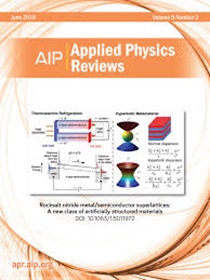Complex thermoelectric transport in Bi-Sb alloys
IF 11.9
1区 物理与天体物理
Q1 PHYSICS, APPLIED
引用次数: 0
Abstract
Bi1−xSbx alloys are classic thermoelectric materials for near-cryogenic applications. Despite more than half a century of study, unraveling the underlying transport physics within this space has been nontrivial due to the complex electronic structure, disorder, and small bandgap within these alloys. Furthermore, as Peltier coolers, Bi1−xSbx alloys operate in a bipolar regime; as such, understanding the impact of minority carriers is critical for further improvements in device performance. This study unites first principles calculations with low-temperature experimental measurements to create a generalized model for transport within semiconducting Bi-Sb alloys. Our exploration reveals the interplay between the complex, degenerate valence band structure with the extremely light conduction bands. By building a hybrid computational/experimental model, an understanding of both the electron and hole relaxation times emerges both as a function of temperature and energy. Special quasi-random supercell calculations reveal that, despite significant atomic disorder, the electronic band structures within the alloy remains largely unaffected and electron–phonon scattering dominates. For charge carriers near the band edges, the relaxation times are thus extremely long, consistent with cyclotronic behavior appearing at low magnetic fields (≪ 1 T). Modeling thermoelectric performance suggests that the valence band edge deformation potential is significantly weaker and highlights the potential for p-type compositions to meet or exceed the current n-type alloys.Bi-Sb合金中的复合热电输运
Bi1−xSbx合金是近低温应用的经典热电材料。尽管经过了半个多世纪的研究,但由于这些合金中复杂的电子结构、无序性和小带隙,解开这个空间内潜在的输运物理一直是不平凡的。此外,作为Peltier冷却器,Bi1−xSbx合金在双极状态下工作;因此,了解少数载波的影响对于进一步提高设备性能至关重要。本研究将第一性原理计算与低温实验测量结合起来,创建了半导体Bi-Sb合金内输运的广义模型。我们的探索揭示了复杂的简并价带结构与极光导带之间的相互作用。通过建立一个混合的计算/实验模型,电子和空穴弛豫时间作为温度和能量的函数出现了。特殊的准随机超级单体计算表明,尽管存在显著的原子无序,但合金内的电子能带结构在很大程度上不受影响,电子-声子散射占主导地位。因此,对于靠近带边缘的载流子,弛豫时间非常长,与在低磁场(≪1 T)下出现的回旋行为相一致。热电性能建模表明,价带边缘变形势明显较弱,并突出了p型成分达到或超过当前n型合金的潜力。
本文章由计算机程序翻译,如有差异,请以英文原文为准。
求助全文
约1分钟内获得全文
求助全文
来源期刊

Applied physics reviews
PHYSICS, APPLIED-
CiteScore
22.50
自引率
2.00%
发文量
113
审稿时长
2 months
期刊介绍:
Applied Physics Reviews (APR) is a journal featuring articles on critical topics in experimental or theoretical research in applied physics and applications of physics to other scientific and engineering branches. The publication includes two main types of articles:
Original Research: These articles report on high-quality, novel research studies that are of significant interest to the applied physics community.
Reviews: Review articles in APR can either be authoritative and comprehensive assessments of established areas of applied physics or short, timely reviews of recent advances in established fields or emerging areas of applied physics.
 求助内容:
求助内容: 应助结果提醒方式:
应助结果提醒方式:


